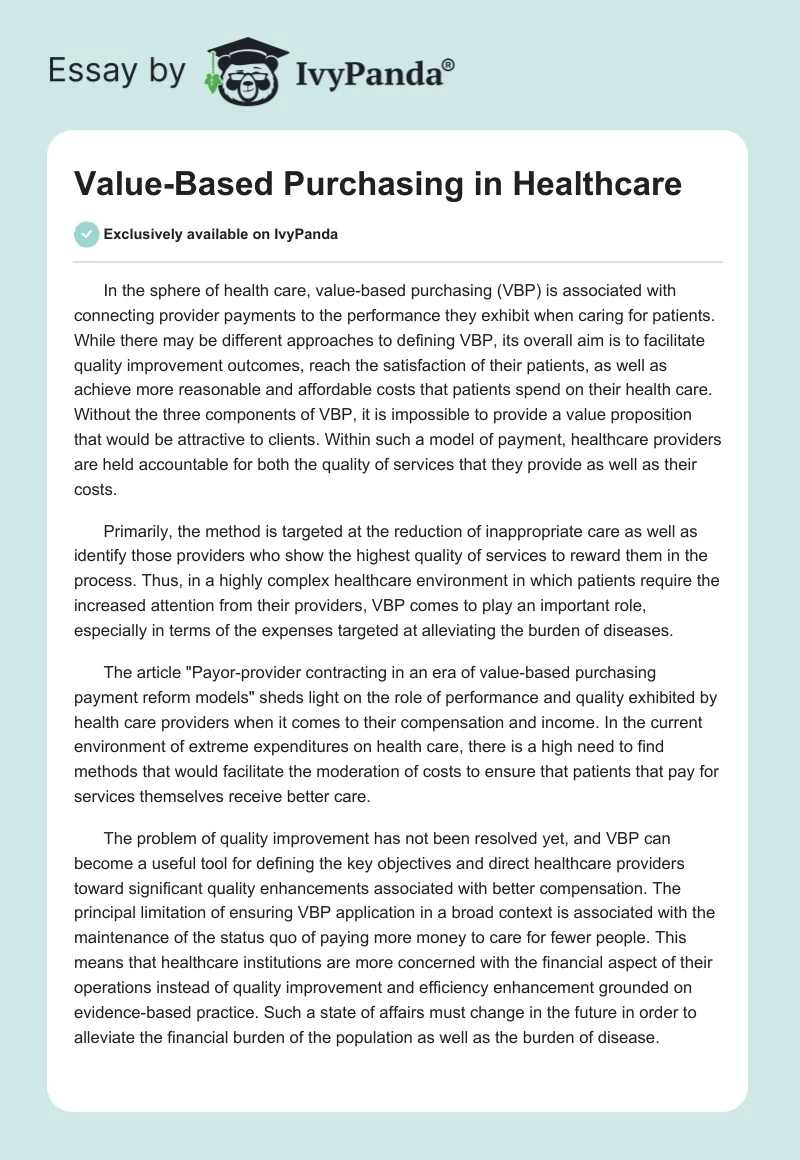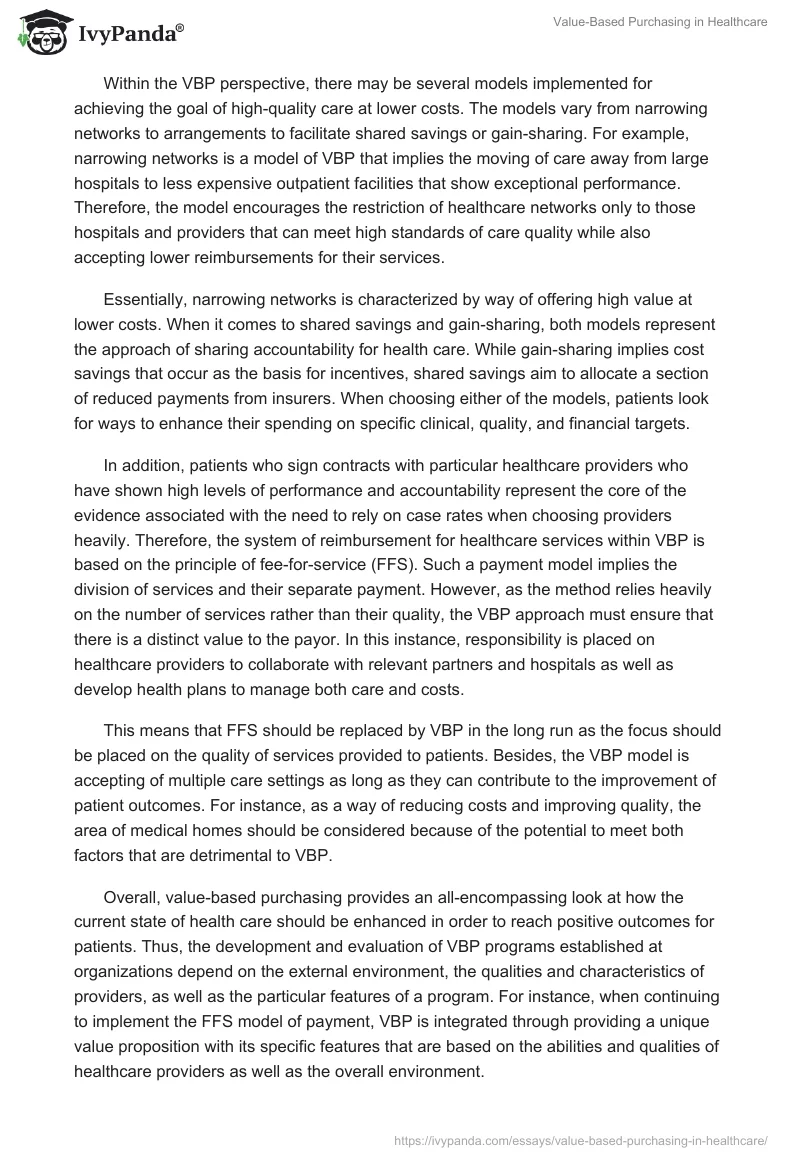In the sphere of health care, value-based purchasing (VBP) is associated with connecting provider payments to the performance they exhibit when caring for patients. While there may be different approaches to defining VBP, its overall aim is to facilitate quality improvement outcomes, reach the satisfaction of their patients, as well as achieve more reasonable and affordable costs that patients spend on their health care. Without the three components of VBP, it is impossible to provide a value proposition that would be attractive to clients. Within such a model of payment, healthcare providers are held accountable for both the quality of services that they provide as well as their costs.
Primarily, the method is targeted at the reduction of inappropriate care as well as identify those providers who show the highest quality of services to reward them in the process. Thus, in a highly complex healthcare environment in which patients require the increased attention from their providers, VBP comes to play an important role, especially in terms of the expenses targeted at alleviating the burden of diseases.
The article “Payor-provider contracting in an era of value-based purchasing payment reform models” sheds light on the role of performance and quality exhibited by health care providers when it comes to their compensation and income. In the current environment of extreme expenditures on health care, there is a high need to find methods that would facilitate the moderation of costs to ensure that patients that pay for services themselves receive better care.
The problem of quality improvement has not been resolved yet, and VBP can become a useful tool for defining the key objectives and direct healthcare providers toward significant quality enhancements associated with better compensation. The principal limitation of ensuring VBP application in a broad context is associated with the maintenance of the status quo of paying more money to care for fewer people. This means that healthcare institutions are more concerned with the financial aspect of their operations instead of quality improvement and efficiency enhancement grounded on evidence-based practice. Such a state of affairs must change in the future in order to alleviate the financial burden of the population as well as the burden of disease.
Within the VBP perspective, there may be several models implemented for achieving the goal of high-quality care at lower costs. The models vary from narrowing networks to arrangements to facilitate shared savings or gain-sharing. For example, narrowing networks is a model of VBP that implies the moving of care away from large hospitals to less expensive outpatient facilities that show exceptional performance. Therefore, the model encourages the restriction of healthcare networks only to those hospitals and providers that can meet high standards of care quality while also accepting lower reimbursements for their services.
Essentially, narrowing networks is characterized by way of offering high value at lower costs. When it comes to shared savings and gain-sharing, both models represent the approach of sharing accountability for health care. While gain-sharing implies cost savings that occur as the basis for incentives, shared savings aim to allocate a section of reduced payments from insurers. When choosing either of the models, patients look for ways to enhance their spending on specific clinical, quality, and financial targets.
In addition, patients who sign contracts with particular healthcare providers who have shown high levels of performance and accountability represent the core of the evidence associated with the need to rely on case rates when choosing providers heavily. Therefore, the system of reimbursement for healthcare services within VBP is based on the principle of fee-for-service (FFS). Such a payment model implies the division of services and their separate payment. However, as the method relies heavily on the number of services rather than their quality, the VBP approach must ensure that there is a distinct value to the payor. In this instance, responsibility is placed on healthcare providers to collaborate with relevant partners and hospitals as well as develop health plans to manage both care and costs.
This means that FFS should be replaced by VBP in the long run as the focus should be placed on the quality of services provided to patients. Besides, the VBP model is accepting of multiple care settings as long as they can contribute to the improvement of patient outcomes. For instance, as a way of reducing costs and improving quality, the area of medical homes should be considered because of the potential to meet both factors that are detrimental to VBP.
Overall, value-based purchasing provides an all-encompassing look at how the current state of health care should be enhanced in order to reach positive outcomes for patients. Thus, the development and evaluation of VBP programs established at organizations depend on the external environment, the qualities and characteristics of providers, as well as the particular features of a program. For instance, when continuing to implement the FFS model of payment, VBP is integrated through providing a unique value proposition with its specific features that are based on the abilities and qualities of healthcare providers as well as the overall environment.
The latter is mostly concerned with the economic situation, possible regulatory changes, payment policies, and the preferences of patients. Thus, in order for FFS to be successfully combined with the aspect of value, healthcare organizations must consider the broad range of factors that can influence the outcomes of their programs. The focus on outcomes is therefore essential when it comes to VBP models because it can prevent the unintended consequences of care or the potentially worsening disparities in healthcare.
The potential for implementing effective VBP models at healthcare organizations is highly extensive. Depending on the payment system, such as fee-for-service or inpatient prospective payment system (IPPS), hospitals will be rewarded with incentives on the basis of the care quality instead of the number of services they offer. The outcomes of quality that should be applied to VBP programs include clinical outcomes, safety, patient and community engagement, as well as efficiency and cost reduction. Based on the quality of services that hospitals provide and the effectiveness of meeting patient expectations and needs, they will get a proportionate level of compensation.
Within the model, accountability is given central focus because of the need to ensure that health care providers reach the degree of quality that would align with their compensation. In addition, VBP will allow differentiating between facilities that offer high-quality services and meet patient expectations and those who show low performance. Assigning pay to quality will therefore indicate the highest and the lowest-performing healthcare institutions, facilitating the increase in engagement as well as the subsequent improvement of patient outcomes within the population.


